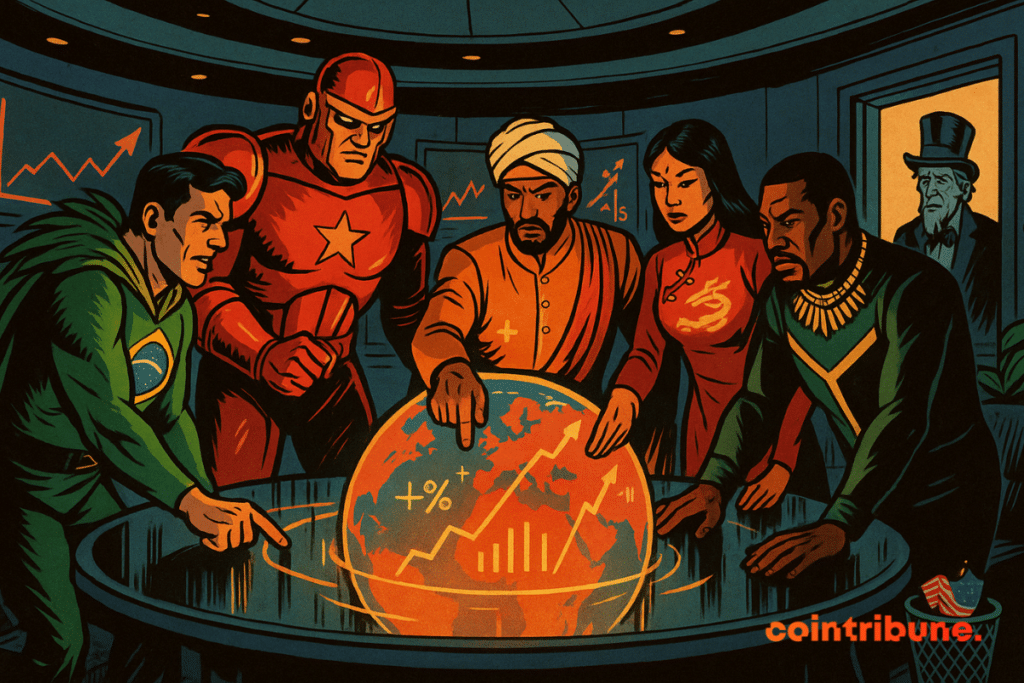21h05 ▪
4
min read ▪ by
Long perceived as followers, the BRICS are now leading global growth. According to the latest IMF forecasts, these emerging powers are set to record in 2025 an economic momentum significantly higher than that of the United States. This quantitative shift becomes strategic : the rise of the BRICS is no longer a trend, it is a fact. Their collective performance is redefining power relations and demands a reassessment of geoeconomic balances.


In Brief
- The BRICS are recording economic growth of 3.4 % in 2025, well above the United States’ projected 1.4 % according to the IMF.
- Countries like India, Ethiopia, and China are driving this dynamic, strengthening the overall weight of the bloc on the global economy.
- The IMF confirms that the BRICS now represent 40 % of global GDP, and up to 41 % in purchasing power parity (PPP).
- The United States, in the midst of economic stagnation, struggles to keep up with this dynamic and may lose its central role in the global economy.
BRICS Growth : A Momentum Beyond Expectations
According to the IMF’s “World Economic Outlook” report published in April 2025, BRICS countries are experiencing combined GDP growth of 3.4 %, well above initial forecasts.
In comparison, the United States is projected at only 1.4 %, reflecting a growing performance gap. Rodrigo Cezar, professor at the Getulio Vargas Foundation (FGV) in Brazil, states:
The BRICS cannot be ignored, given the size of their population and GDP in 2025.
This comment reflects a paradigm shift. Emerging economies, long seen as followers, are now establishing themselves as global growth engines.
Indeed, the IMF report outlines the growth projections for several members and partners of the BRICS alliance for 2025. These figures show marked economic vitality as well as a structured rise in geoeconomic power:
- Ethiopia : +6.6 % ;
- India: +6.2 % ;
- Indonesia: +4.7 % ;
- United Arab Emirates: +4 % ;
- China: +4 % ;
- South Africa: +3.4 % ;
- Brazil: +2.3 %.
Furthermore, the IMF indicates that the BRICS now constitute 40 % of global GDP, a figure rising to 41 % in purchasing power parity (PPP). This distribution reflects a shift of the global economic epicenter toward the Global South.
Far from being a mere statistical signal, this growing economic weight is beginning to produce concrete effects on international financial balances.
An Increased Strategic Influence on Global Markets
Beyond growth figures alone, 2025 sees a redefinition of power relations in global trade. Rodrigo Cezar points out that some BRICS countries, like Russia and Brazil, play a crucial role in strategic supply chains.
“They are key suppliers of energy, food, and strategic minerals“, he explains. Such a position grants them major influence over global commodity prices, making markets increasingly sensitive to the internal dynamics of the BRICS bloc.
Geopolitical tensions and U.S. tariff policies have only intensified this shift. Faced with limited growth and increasing tariff isolation, the U.S. economy “is walking a tightrope“.
The contrast is all the more pronounced as the BRICS simultaneously pursue a strategy of de-dollarization, aiming to reduce their dependence on the greenback and assert their financial autonomy. Although this aspect was not detailed in the IMF report, it forms an increasingly audible undertone.
Maximize your Cointribune experience with our “Read to Earn” program! For every article you read, earn points and access exclusive rewards. Sign up now and start earning benefits.
Diplômé de Sciences Po Toulouse et titulaire d’une certification consultant blockchain délivrée par Alyra, j’ai rejoint l’aventure Cointribune en 2019.
Convaincu du potentiel de la blockchain pour transformer de nombreux secteurs de l’économie, j’ai pris l’engagement de sensibiliser et d’informer le grand public sur cet écosystème en constante évolution. Mon objectif est de permettre à chacun de mieux comprendre la blockchain et de saisir les opportunités qu’elle offre. Je m’efforce chaque jour de fournir une analyse objective de l’actualité, de décrypter les tendances du marché, de relayer les dernières innovations technologiques et de mettre en perspective les enjeux économiques et sociétaux de cette révolution en marche.
DISCLAIMER
The views, thoughts, and opinions expressed in this article belong solely to the author, and should not be taken as investment advice. Do your own research before taking any investment decisions.

